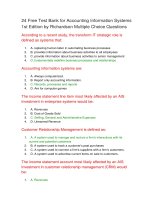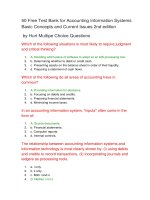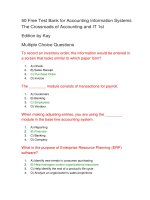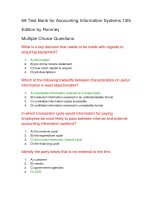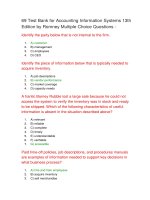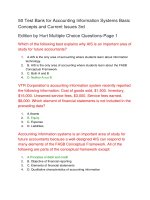47 test bank for accounting information systems 10th
Bạn đang xem bản rút gọn của tài liệu. Xem và tải ngay bản đầy đủ của tài liệu tại đây (30.71 KB, 10 trang )
47 Test Bank for Accounting Information Systems 10th
Edition by Gelinas Multiple Choice Questions
A man-made system that generally consists of an integrated set of
computer-based components and manual components established
to collect, store, and manage data and to provide output information
to users.
1.
a. information system
2.
b. output system
3.
c. business event system
4.
d. database system
Enterprise systems
1.
a. integrate back-office and front-office processes
2.
b. can include ERP systems
3.
c. have become fairly easy to implement
4.
d. facilitate business processes between organizations
At which level of the organization are decisions most unstructured?
1.
a. operations and business event processing level
2.
b. strategic management level
3.
c. operations management level
4.
d. tactical management level
Which of the following is one of the three most prominent
management activities?
1.
a. production
2.
b. finance
3.
c. marketing
4.
d. planning
Which of the following statements is false?
1.
a. Management designs the operations and information processes and
establishes these processes with people, equipment, and policies.
2.
b. Information process users include operations personnel, management, and
people outside the organization.
3.
c. Operations related and accounting related processes are designed by
those external to the organization.
4.
d. None of the statements are false.
A man-made system consisting of people, equipment, organization,
policies and procedures with the objective of accomplishing the
work of the organization.
1.
a. operations process
2.
b. management process c. information process
3.
d. planning process
Generally, which of the following is NOT one of the three roles an
accountant typically fills in relation to the AIS?
1.
a. designer
2.
b. programmer
3.
c. user
4.
d. auditor
Historically, the relationship between an information system and an
accounting information system has been:
1.
a. the AIS is a part of the IS
2.
b. the IS is a part of the AIS
3.
c. the IS and the AIS are one in the same
4.
d. the IS and AIS are unrelated
Which of the following is NOT a business processes element?
1.
a. Business operations
2.
b. Events processing
3.
c. Management decision making
4.
d. Technology
The central repository for all the data related to the enterprise's
business activities and resources.
1.
a. information system
2.
b. management information system
3.
c. enterprise database
4.
d. strategic planning
The degree to which information includes data about every relevant
object or event necessary to make a decision is
1.
a. accuracy
2.
b. completeness
3.
c. neutrality
4.
d. comparability
The AICPA has identified all but which of the following as assurance
services?
1.
a. consulting
2.
b. information systems reliability
3.
c. electronic commerce
4.
d. All of these are assurance services identified by the AICPA.
Which of the following questions might the accountant answer in the
design of the AIS?
1.
a. what will be recorded
2.
b. what controls are necessary
3.
c. what reports will be produced
4.
d. all of the above
Which of the following is an unstructured decision?
1.
a. how much inventory to reorder
2.
b. how fast an assembly line should operate
3.
c. when scheduled maintenance should be performed
4.
d. which research and development projects should be undertaken
A man-made system consisting of people, authority, organization,
policies and procedures whose objective is to accomplish the work
of planning and controlling the operations of the organization.
1.
a. operations process
2.
b. management process
3.
c. information process
4.
d. planning process
All of the following are components of reliability except:
1.
a. validity
2.
b. accuracy
3.
c. verifiability
4.
d. feedback value
Which of the following statements is true?
1.
a. The information process facilitates operations by maintaining data such as
inventory and customer data.
2.
b. The information process provides the means by which management
monitors the operations process.
3.
c. Management designs the operations and information processes.
4.
d. All of the statements are true.
A set of interdependent elements that together accomplish specific
objectives is a
1.
a. system
2.
b. subsystem
3.
c. database
4.
d. accounting information system
E-business does not include
1.
a. business processes between individuals and organizations
2.
b. electronic networks
3.
c. ERP systems
4.
d. interaction between back-office and front-office processes
Structured decision
1.
a. are usually tactical management decisions
2.
b. require the use of an organization’s AIS system.
3.
c. are relatively routine and repetitive
4.
d. All of the above
The three themes of the text book include all of the following
except:
1.
a. enterprise systems
2.
b. risk assessment
3.
c. e-business
4.
d. internal control
According to the ____, one of the responsibilities of accountants is
to assess financial operations and make best-practices
recommendations to management.
1.
a. AICPA
2.
b. Sarbanes-Oxley Act of 2002
3.
c. Occupational Outlook Handbook
4.
d. Accounting Information System
____ improves the decision maker's capacity to predict, confirm, or
correct earlier expectations
1.
a. Understandability
2.
b. Feedback value
3.
c. Neutrality
4.
d. Comparability
Which of the following statements is false?
1.
a. Strategic planning is relatively unstructured.
2.
b. Strategic planning uses much information from outside the firm.
3.
c. Tactical management focuses on relevant operations units and uses some
external information.
4.
d. Tactical management uses the most detailed and accurate information.
The ____ manager may be more concerned with accuracy than
with timeliness.
1.
a. strategic
2.
b. tactical
3.
c. operations
4.
d. All of the above.
Which of the following is an element of the operations process?
1.
a. production
2.
b. planning
3.
c. controlling
4.
d. decision making
The Sarbanes-Oxley Act of 2002 dramatically changed the daily
work of financial accountants and auditors because it
1.
a. expanded the scope of the audit beyond financial information
2.
b. required that organizations work with their auditors to design systems of
internal control
3.
c. required that external auditors report on the effectiveness of an
organizations system of internal control
4.
d. expanded the opportunities for auditors to engage in consulting activities
with their audit clients
____ are facts and figures in raw form.
1.
a. Data
2.
b. Information
3.
c. Objectives
4.
d. Goals
____ is (are) data presented in a form that is useful to decision
makers.
1.
a. Activities
2.
b. Information
3.
c. Objectives
4.
d. Goals
Which of the following is NOT one of the three steps in decision
making as described in the text
1.
a. action
2.
b. intelligence
3.
c. design
4.
d. choice
An information system:
1.
a. is composed of only the computer-based information resources of an
organization
2.
b. may consist of both computer-based and manual components
3.
c. is different from a data processing system because it uses computers
4.
d. is not generally used for transaction processing
The ability of more than one individual to come to the same
measurement is known as
1.
a. accuracy
2.
b. completeness
3.
c. verifiability
4.
d. comparability
If information arrives too late to impact a decision then there is a
problem with
1.
a. timeliness
2.
b. relevance
3.
c. completeness
4.
d. neutrality
The correspondence or agreement between the information and the
actual events or objects that the information represents is known
as
1.
a. accuracy
2.
b. completeness
3.
c. neutrality
4.
d. comparability
Internal control is a process designed to provide absolute
assurance regarding achieving objectives in which of the following?
1.
a. efficiency and effectiveness of operations
2.
b. reliability of reporting
3.
c. compliance with applicable laws and regulations
4.
d. none of the above
____ requires information to assess the environment and to project
future events and conditions.
1.
a. Strategic management
2.
b. Tactical management
3.
c. Operations management
4.
d. Operations and business event processing
A system can be further divided into
1.
a. input data
2.
b. subsystems
3.
c. databases
4.
d. enterprise systems
The three logical components of a business process include all of
the following except:
1.
a. management process
2.
b. operations process
3.
c. information process
4.
d. organization process
The information quality that enables users to identify similarities and
differences in two pieces of information is
1.
a. Understandability
2.
b. Predictive value
3.
c. Neutrality
4.
d. Comparability
Regarding management problem structure and information
requirements, which of the following represents the vertical
information flows from lowest to highest?
1.
a. strategic management, tactical management, operations management,
operations and business event processing
2.
b. operations and business event processing, strategic management, tactical
management, operations management
3.
c. tactical management, operations management, strategic management,
operations and business event processing
4.
d. operations and business event processing, operations management,
tactical management, strategic management
Accounting is an activity of the
1.
a. management process
2.
b. operations process
3.
c. information process
4.
d. organization process
The text takes the following view of the relationship between an IS
and an AIS:
1.
a. the AIS is part of the IS
2.
b. the IS is part of the AIS
3.
c. the IS and the AIS are one in the same
4.
d. the AIS is the primary system and the IS the subsystem
Efficiency and effectiveness of operations are goals of:
1.
a. enterprise systems
2.
b. risk assessment
3.
c. e-business
4.
d. internal control
Decision-making is an activity of the
1.
a. management process
2.
b. operations process
3.
c. information process
4.
d. organization process
The sequence of components in the functional model of an
information system is
1.
a. Output, Input, Processing, Users
2.
b. Input, Processing, Output, Users
3.
c. Processing, Input, Users, Output
4.
d. Users, Processing, Input, Output
All of the following are components of relevance except:
1.
a. feedback value
2.
b. predictive value
3.
c. verifiability
4.
d. timeliness
A system that consists of an integrated set of computer-based and
manual components established to collect, store, and manage data
and to provide output information to users is a(n)
1.
a. output
2.
b. ERP
3.
c. database
4.
d. information system
